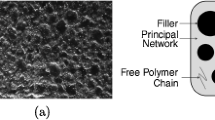Abstract
A microstructure model for SBS and SIS triblock copolymers with hard domains as multifunctional reinforcing fillers is proposed. Based on this model and proposed mechanism of large deformations, the probability distribution function of the end-to-end vector for each constituent chain and the free energy of deformation for the total networks was calculated by the combination of statistical thermodynamics and kinetics. A new molecular theory of non-linear visco-elasticity for SBS and SIS at large deformations is presented. It is successful in relating the viscoelastic state to molecular constitution by three important parameters (C 100,C 020, andC 200) of the networks. The relations of stress to strain for four types of deformation, the elastic modulus and the constitutive equation for the stress relaxation were derived from this theory. It provides a theoretical foundation for studying the relationships of multiphase network structures and mechanical properties at large deformations. An excellent agreement between the theoretical relationships and experimental data from the experiments and the reference was obtained.
Similar content being viewed by others
References
Molau GE (1970) Block Polymer. Plenum Press, New York, p 79
Noshay A, Mcgrath JE (1977) Block Copolymer overview and critical survey. Academic Press, New York, p 218
Beecher JF, Marker L, Brandford RD, Aggarwal SL (1969) J Polymer Sci C26:117
Vinogradov GV, Dreval VE, Borisenkova EK (1982) Intern J Polymeric Mater 9:105
Pedemonte E, Dondero G, Alfonso GC, Candia FD (1975) Polymer 16:531
Pedemonte E, Alfonso GC, Dondero G, Candia FD, Araimo L (1977) Polymer 18:191
Fischer E, Henderson JF (1969) J Polym Sci C26:149
Gumbrell SM, Millins L, Rivlin RS (1953) Trans Faraday Soc 49:1495
Smallwood HM (1965) J Appl Polymer Sci 9:2993
Tschoegl NW (1971) J Polymer Sci A-1, 9:2993
Holden G, Bishop ET, Legge NR (1969) J Polymer Sci C26:37
Aggarwal SL (1979) Shell Polymer 3(2):43; also see, Polymer 17:938
Pakula T, Saijo K, Kawai H, Hashimoto T (1985) Macromolecules 18:1294
Tanaka H, Nishi T (1985) J Chem Phys 82(9):4326
Diamant T, Wispell MC, Soane DC (1988) Polym Eng Sci 28(4):207
Song MS (1985) J China Univ Sci Technol 15:285; (1986) 16:162
Song MS (1987) Polymer Bulletin 17:63
Song MS (1988) Chinese Journal of Chemical physics 1(2):126
Song MS (1988) J Chem Industry Eng 39(1):20
Morman KN, Pan TY (1988) Rubb Chem Technol 61(3):505
Morman KN (1988) Rheol Acta 27:3
Hu GX et al (1987) Computer and Applied Chem (2):94
Author information
Authors and Affiliations
Additional information
Project supported by the National Natural Foundation of China
Rights and permissions
About this article
Cite this article
Song, M.S., He, Z.R. The molecular theory of viscoelasticity for thermoplastic elastomer SBS (SIS) at large deformations. Rheol Acta 29, 31–45 (1990). https://doi.org/10.1007/BF01331799
Received:
Revised:
Issue Date:
DOI: https://doi.org/10.1007/BF01331799




